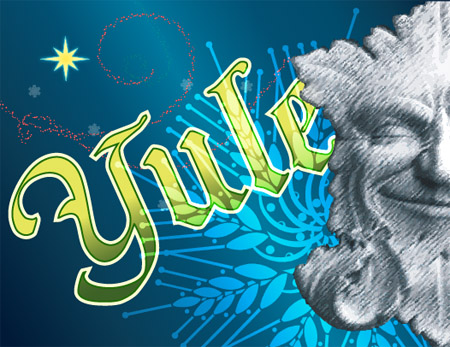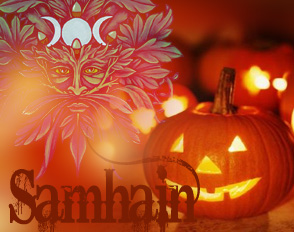Falling between the 19th and the 23rd day of December, and also known as the Winter Solstice, Yule (pronounced EWE-elle) is the time when the dark half of the year yields to the light half, marking the shortest day of the year accompanied by what is also known as Solstice Night, the longest night of the year.
We now begin our return closer to the sun, as the sky holds the sun for a little longer each day, it begins to get a little warmer as well.
In ancient times this moment in the wheel of the year was celebrated joyfully, honoring the “rebirth of the Oak King”, the Sun King (the return of the sun), Giver of Life that envelopes the frozen Earth, giving her the warmth she needs to bear forth the seeds she protected in her womb through the fall and winter days. Bonfires decorated the fields, as the crops, trees and gardens were sprinkled with cider as a blessing.
It was tradition going from house to house offering gifts, such as handmade baskets of evergreen boughs, filled with clove spiked apples and oranges, and wheat stalks dusted with flour. The apples and oranges represented the sun, the boughs were symbolic of immortality, the wheat stalks portrayed the harvest, and the flour was accomplishment of triumph, light, and life. Holly, mistletoe, and ivy not only decorated the outside, but also the inside of homes. It was to extend invitation to Nature Sprites to come and join the celebration. A sprig of Holly was kept near the door all year long as a constant invitation for good fortune to pay visit to the residents.
The ceremonial Yule log was the highlight of the festival. In accordance to tradition, the log must either have been harvested from the householder’s land the previous year (kept for this specific purpose), or given as a gift… it must never have been bought. Once in the house, placed in the fireplace it was decorated in seasonal greenery, doused with cider or ale, and dusted with flour before set ablaze. The log would burn throughout the night, then smolder for 12 days after before being ceremonially put out. Ash is the traditional wood of the Yule log. It is the sacred world tree of the Teutons, known as Yggdrasil. An herb of the Sun, Ash brings light into the hearth at the Solstice.
A different type of Yule log, perhaps more suitable for modern practitioners would be Oak or Pine. For the three candles, find a smaller branch of oak or pine, and flatten one side so it sets upright. Carve, or drill, three holes on the top side to hold a red, a green, and a white candle for the season; or a green, a gold, and a black candle for the Sun God; or a white, a red, and a black candle for the Great Mother Goddess. Continue to decorate with greenery, red and gold bows, rosebuds, cloves, and dust with flour.
Deities of Yule are all Newborn Gods, Sun Gods, Mother Goddesses, and Triple Goddesses. The best known would be Dagda, and Brighid, the daughter of Dagda. Brighid taught the smiths the arts of fire tending and the secrets of metal work. Brighid’s flame, like the flame of the new light, pierces the darkness of the spirit and mind, while Dagda’s cauldron assures that Nature will always provide for all the children.
Symbolism of Yule: Rebirth of the Sun, The longest night of the year, The Winter Solstice, Introspect, Planning for the Future.
Symbols of Yule: Yule log, or small Yule log with 3 candles, evergreen boughs or wreaths, holly, mistletoe hung in doorways, gold pillar candles, baskets of clove studded fruit, a simmering pot of wassail, poinsettias, christmas cactus.
Herbs of Yule: Bayberry, blessed thistle, evergreen, frankincense holly, laurel, mistletoe, clove, oak, pine, sage, yellow cedar.
Foods of Yule: Cookies and caraway cakes soaked in cider, fruits (mainly apples and oranges), nuts, eggnog, ginger tea, spiced cider and ale.
Incense of Yule: Pine, cedar, bayberry, cinnamon.
Colors of Yule: Red, green, gold, white, silver, yellow, orange.
Stones of Yule: Rubies, bloodstones, garnets, emeralds, diamonds.
Activities of Yule: Caroling, wassailing the trees and crops, burning the Yule log, decorating the Yule tree, exchanging of presents, kissing under the mistletoe, dancing by the bonfire, honoring Kriss Kringle the Germanic Pagan God of Yule
Spellworkings of Yule: Peace, harmony, love, abundance and increased happiness.
Deities of Yule: Goddesses-Brighid, Dagda, Isis, Demeter, Gaea, Diana, The Great Mother. Gods-Apollo, Ra, Odin, Lugh, The Oak King, The Sun King, The Horned One, The Divine Child.
For a Harvest & Mabon ritual visit Divine Muse: Winter Solstice Ritual
Moravian Scotch Cakes
1 1/2 cups veg. butter
1/2 cup brown sugar
4 cups flour
2 tsp. caraway seeds
Mix the flour, caraway seeds and sugar together. Work in the butter with the finger tips until well blended. Roll out about 1/3 inch thick on floured board. Cut in small squares. Bake on a greased cookie sheet at 325° about 15 minutes. When cold, cover with icing and sprinkle with colored sugar.
–
Acorn Squash and Sweet Potato Soup
1 large onion, chopped (1 cup)
1 Tbsp. vegetable oil
1 1/2 lbs. sweet potatoes, peeled and cubed (5 cups)
1 small acorn squash, seeded and cubed
13 3/4 oz. vegetable broth
4 Tbsp. rice milk
1/2 tsp. salt
1/4 tsp. pepper
2 Tbsp. sliced almonds; toasted
ground nutmeg
Heat oil in a large saucepan. Then over medium heat sauté onions until golden, about 8 minutes. Add potatoes, squash and broth. Simmer, covered, until vegetables are tender, about 25 minutes. Cool slightly. Working in small batches, place the vegetables with the liquid in a blender or food processor. Whirl until pureed. Return the puree to the saucepan. Stir in milk to desired consistency. Season with salt and pepper. Heat over low heat. Remove to heated bowls. Top each serving with a sprinkle of almonds and nutmeg.
–
Sweet Potatoes and Cranberries
6 sweet potatoes
1 cup cranberry sauce
3/4 cup fresh orange juice
1/2 cup brown sugar
3/4 tsp. orange rind
3/4 tsp. cinnamon
1 1/2 Tbsp. veg. butter
1 cup cranberries
1/4 tsp. nutmeg
Boil sweet potatoes in their skins until barely tender. Peel, slice thickly, and arrange in a buttered baking dish. In a saucepan, mix remaining ingredients. Simmer, uncovered, for five minutes. Pour over sweet potatoes and bake uncovered at 350° for 20 minutes or until glazed and hot.
–
Yule Moon Cookies
1 cup butter
1 1/4 cup sugar
2 tsp. grated lemon peel
1/4 tsp. salt
1 1/3 cup flour
1 1/2 cup grated almonds (blanched)
1 tsp. vanilla
Icing:
2 cups sifted confectioner’s sugar
1 tsp. vanilla
2 1/2 Tbsp. water
Cream together butter and sugar until fluffy and light. Add grated lemon peel, salt, flour, grated almonds, and 1 tsp. vanilla; mix thoroughly. Place dough in bowl. Cover and chill thoroughly. When the dough is well chilled; or the next day, roll out dough to 1/8″ thickness and cut with moon/crescent cookie cutter. Place 1/2″ apart on un-greased baking sheet. Bake in preheated 375° oven for 8-10 minutes.
Icing:
While cookies bake, combine confectioner’s sugar, vanilla and water. Spread over the tops of cookies while still warm, but not too hot, as icing will melt. Thin with additional drops of water if glaze is too thick. Allow cookies to cool.
Makes: 10 dozen cookies
–
Yuletide Slaw
4 cups red cabbage, shredded
1/4 cup lemon juice
1/2 teaspoon black pepper, corse ground
1 teaspoon salt
1/2 cup green onions, chopped
2 teaspoons sugar
1/4 cup salad oil
2 tablespoons parsley
1 green bell pepper, chopped
Combine and toss the vegetables together. Mix salt, pepper, salad oil, lemon juice, sugar and parsley and pour over the vegetable mixture. Refrigerate for 1 hour, Toss briskly before serving.
Makes 8 servings.
–
Hot Spiced Wassail (non-alcoholic)
4 cups cranberry juice
6 cinnamon sticks
5 cups apple cider
1 orange, studded with whole cloves
1 cup water
1 apple, cored and sliced
1/2 cup brown sugar
Mix juice, cider, and water in large saucepan or crock pot. Add cinnamon sticks, clove studded orange, and apple slices. Simmer mixture for 4 hours. Serve hot.
Makes 12 servings.
–
Solstice Surprise Salad
1 large unpeeled cucumber
1 15 1/2 ounce can whole chestnuts
4 ounces cheddar cheese
3 tablespoons French dressing
Wash and dry cucumber. Cut into quarters, lengthwise, then thinly slice into a non-metal bowl. Grate cheddar cheese and add to cucumber. Break up the chestnuts into fairly large pieces and add. Toss well to mix, adding the French dressing. Chill for one hour before serving.
Makes 6 servings.
–
Raspberry Marsh-Bars
1/4 pound butter
10 ounce raspberry chocolate chips
12 ounce can evaporated milk
2 ounces bittersweet chocolate
3 1/2 cups sugar
7 ounce jar marshmallow creme
1 heaping tablespoon of instant coffee
1 teaspoon vanilla
In heavy saucepan or double boiler melt the butter. Add evaporated milk, sugar, and coffee. Bring to a rolling boil, stirring constantly. Remove from heat and add raspberry chocolate chips and bittersweet chocolate. Stir the mixture until all ingredients are melted. Add the marshmallow creme and stir until well blended. Stir in the vanilla. Pour into a slightly greased 9″ x13″ pan. Refrigerate. Cut into bite-sized bars when cooled.
Makes 12 servings.
–
Recipes sources:
Celtic Connection www.wicca.com
Ravenna’s Wheel of the Year www.angelfire.com/wa3/angelline






